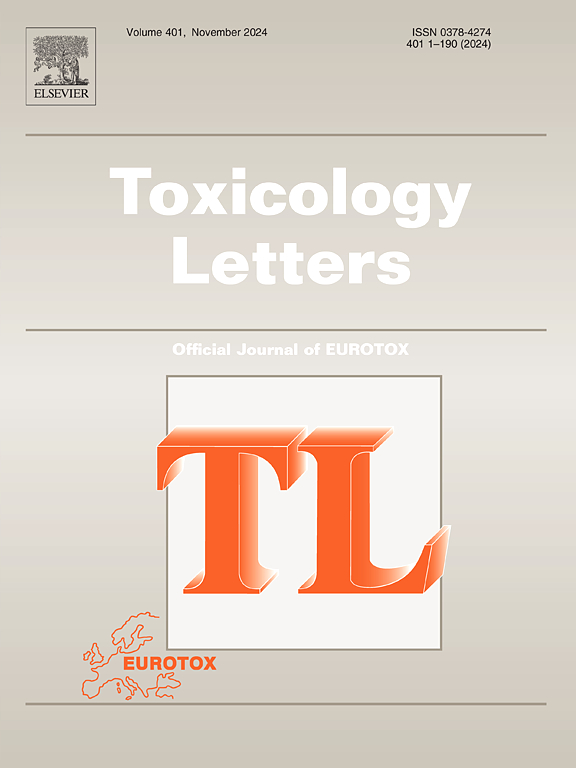Dose-, stage- and sex- difference of prenatal prednisone exposure on placental morphological and functional development
IF 2.9
3区 医学
Q2 TOXICOLOGY
引用次数: 0
Abstract
Prednisone, a synthetic glucocorticoid, is commonly used to treat autoimmune diseases in pregnant women. However, some studies suggest that the use of prednisone during pregnancy may lead to adverse pregnancy outcomes. In this study, we established PPE mouse models at different doses (0.25, 0.5, 1.0 mg/kg·d) and different stages (whole pregnancy, early pregnancy and middle-late pregnancy) and determined outcomes on the placenta and fetus. The results of our study indicated that at the highest dose of 1 mg/kg PPE using a GD 0–18 dosing regime, PPE caused placental morphological changes measured as a decrease in placental weight relative to controls and a decrease in the placenta junctional zone (JZ)/labyrinth zone (LZ) ratio. No changes were observed on the fetuses for number of live, stillborn, and absorbed fetuses between the experimental groups and the control group. In the placentas at some doses, there were decreases in cell proliferation markers measured at the RNA and protein level by Western blot and increased apoptosis. Measures of gene expression at the mRNA level showed altered nutrients (including glucose, amino acid, and cholesterol) transport gene expressions with the most significant change associated with the male placentas at high-dose and whole pregnancy PPE group. It was further found that PPE led to the inhibition of the insulin-like growth factor 2 (IGF2)/insulin-like growth factor 1 receptor (IGF1R) signaling pathway, which was well correlated with the indicators of cell proliferation, syncytialization and nutrient (glucose and amino acid) transport indices. In conclusion, PPE can alter placental morphology and nutrient transport function, with differences in effect related to dose, stage and gender. Differential gene expressions measured for genes of the IGF2/IGF1R signaling pathway suggested this pathway may be involved in the effects seen with PPE. This study provides a theoretical and experimental basis for enhancing the understanding of the effects of prednisone use on placenta during human pregnancy but does not currently raise concerns for human use as effects were not seen on the fetuses and while the effects on cell proliferation are informative they were inconsistent and the differential effects on female and male placentas unexplained suggesting that further work is required to elucidate if these findings have relevance for human use of PPE during pregnancy.
产前泼尼松暴露对胎盘形态和功能发育的剂量、阶段和性别差异。
泼尼松是一种人工合成的糖皮质激素,常用于治疗孕妇的自身免疫性疾病。然而,一些研究表明,孕期使用泼尼松可能会导致不良妊娠结局。在本研究中,我们建立了不同剂量(0.25、0.5、1.0mg/kg-d)和不同阶段(整个妊娠期、妊娠早期和妊娠中晚期)的 PPE 小鼠模型,并测定了其对胎盘和胎儿的影响。研究结果表明,在 GD 0-18 剂量制度下,最高剂量为 1mg/kg PPE 时,PPE 会引起胎盘形态学变化,表现为胎盘重量相对于对照组的减少,以及胎盘连接区(JZ)/迷宫区(LZ)比率的降低。实验组和对照组的胎儿在活胎、死胎和吸收胎的数量上没有变化。在某些剂量的胎盘中,通过 Western 印迹法测定的 RNA 和蛋白质水平的细胞增殖标志物减少,细胞凋亡增加。mRNA 水平的基因表达测量显示,营养物质(包括葡萄糖、氨基酸和胆固醇)转运基因表达发生了改变,其中与高剂量和整个孕期 PPE 组男性胎盘相关的变化最为显著。研究进一步发现,PPE 导致胰岛素样生长因子 2(IGF2)/胰岛素样生长因子 1 受体(IGF1R)信号通路受到抑制,这与细胞增殖、合胞化和营养物质(葡萄糖和氨基酸)转运指数等指标密切相关。总之,PPE 可改变胎盘形态和营养运输功能,其影响差异与剂量、阶段和性别有关。IGF2/IGF1R信号通路基因的差异表达表明,该通路可能与PPE的影响有关。这项研究为进一步了解人类妊娠期间使用泼尼松对胎盘的影响提供了理论和实验基础,但目前并未引起对人类使用泼尼松的关注,因为没有发现对胎儿的影响,尽管对细胞增殖的影响具有参考价值,但这些影响并不一致,而且对女性和男性胎盘的不同影响也没有得到解释。
本文章由计算机程序翻译,如有差异,请以英文原文为准。
求助全文
约1分钟内获得全文
求助全文
来源期刊

Toxicology letters
医学-毒理学
CiteScore
7.10
自引率
2.90%
发文量
897
审稿时长
33 days
期刊介绍:
An international journal for the rapid publication of novel reports on a range of aspects of toxicology, especially mechanisms of toxicity.
 求助内容:
求助内容: 应助结果提醒方式:
应助结果提醒方式:


